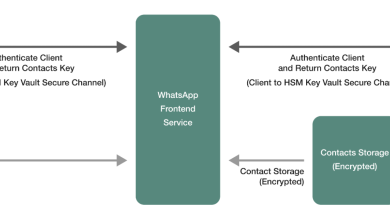Double Opt-In: What It Is And Why You Need It

Do you want an effective, sustainable method for building a healthy mailing list? Then double opt-in is for you.
Whether you work on this yourself or hire an email marketing consultant to do this for you and more, you’ll ensure that you’ll get the authentic and active email address leads your brand needs. You will also protect your brand reputation.
What Is Double Opt-In?
When a user signs up for your email list, you email this user asking them to confirm their subscription through a link you provide, and they click on this link—this is a double opt-in.
Double opt-in is also known as “confirmed opt-in.” Fundamentally, it’s taking this extra step to make sure that your email subscribers really know what they’re signing up for. This shows them respect.
This is also a way for them to show you that they’re genuinely interested in receiving your emails. They first indicated their interest by signing up on your website’s subscription form. Then, they confirm their interest and free choice to receive emails from you by using the opt-in link you emailed to them.
But–you say–why would you go to all this trouble when you get more subscribers with a single opt-in? Besides, your emails already have an unsubscribe link, anyone not interested in receiving your emails can always unsubscribe, can’t they?
Valid questions, and we’ll address them here by discussing the pros and cons of double opt-in:
Double Opt-In Pros
1. Increases your email deliverability
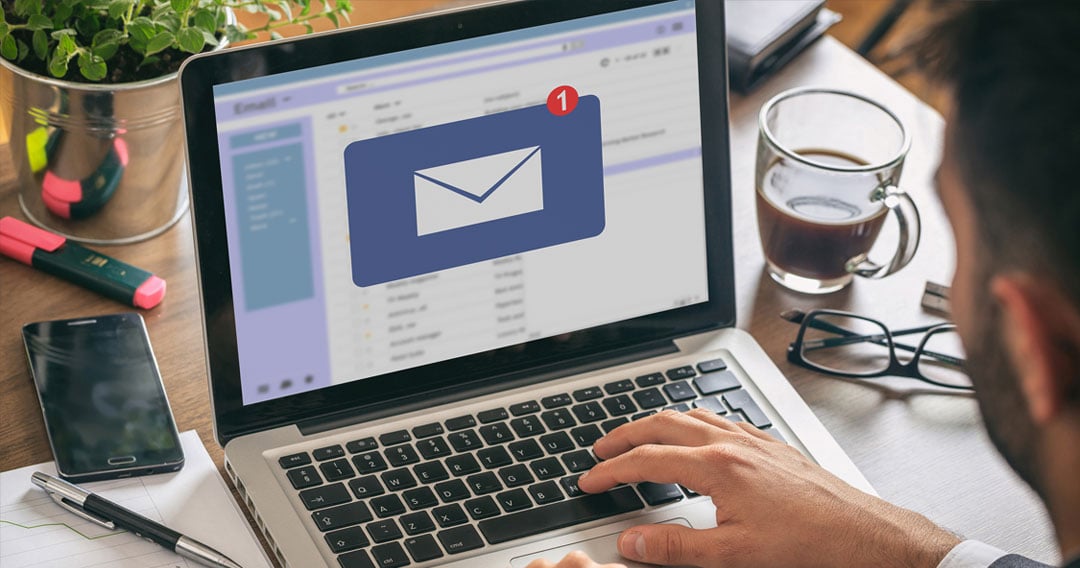
With double opt-in, there is zero chance of invalid/erroneous email addresses. You also prevent spam email addresses from getting into your email list.
You’re probably familiar with the scenario of a user making a typo when they sign up for your emails on your website. Then, when you email them, your email bounces.
If this happens a lot, your email-sending domain’s reputation takes a hit. Email Service Providers (ESPs) will think you’re a spammer and send your email to the user’s spam folder.
However, with double opt-in, the user who is genuinely interested in receiving your emails will wonder why they did not get a confirmation from you. They could try signing up at your website again if they realize their typo error or email you for support. Or, they could just forget about it, which shows you that they’re not that interested anyway. Still, users clicking on your confirmation link signals the ESPs positively, increasing your chances of inbox placement in the future.
Double opt-in also helps you avoid spam traps. There’s the pure spam trap where ISPs deliberately create duplicate email accounts and circulate them across web pages to identify spammers. Spammer-programmed web crawlers (spambots) copy these addresses to create bulk email lists (email harvesting or scraping) to spam sign-up forms or sell these lists in the market.
There’s also the recycled spam trap. This comes from inactive email accounts. A good email marketer regularly identifies inactive contacts, segments them, and re-engages them. If these inactive contacts don’t respond, their records should be deleted from the list. If they’re not deleted and you keep sending them emails, the ESPs will convert your emails into the spam trap. This also lowers your email conversion rates.
Using double opt-in to eliminate invalid and spam email addresses ensures that the email addresses you have in your list are from real people who are truly interested in your brand’s content. You get a quality list of verified email addresses, and your emails have higher deliverability rates.
2. Shows authentic user interest in your brand and content
Since double opt-in is an added step for them to take, users who confirm their subscription indicate their genuine interest in your content. This leads to greater potential for engagement down the road and, ultimately, better email marketing strategy results.
MailChimp’s study of 30,000 users showed that double opt-in lists had better open rates, with a 72.2% increase in unique opens and a 75.6% increase in total opens. They also had better click rates at a 114% increase over single opt-ins. Double opt-ins also had significantly lower email bounce rates (48.3%) and unsubscribe rates (7%) than single opt-ins.
3. Keeps you legally compliant
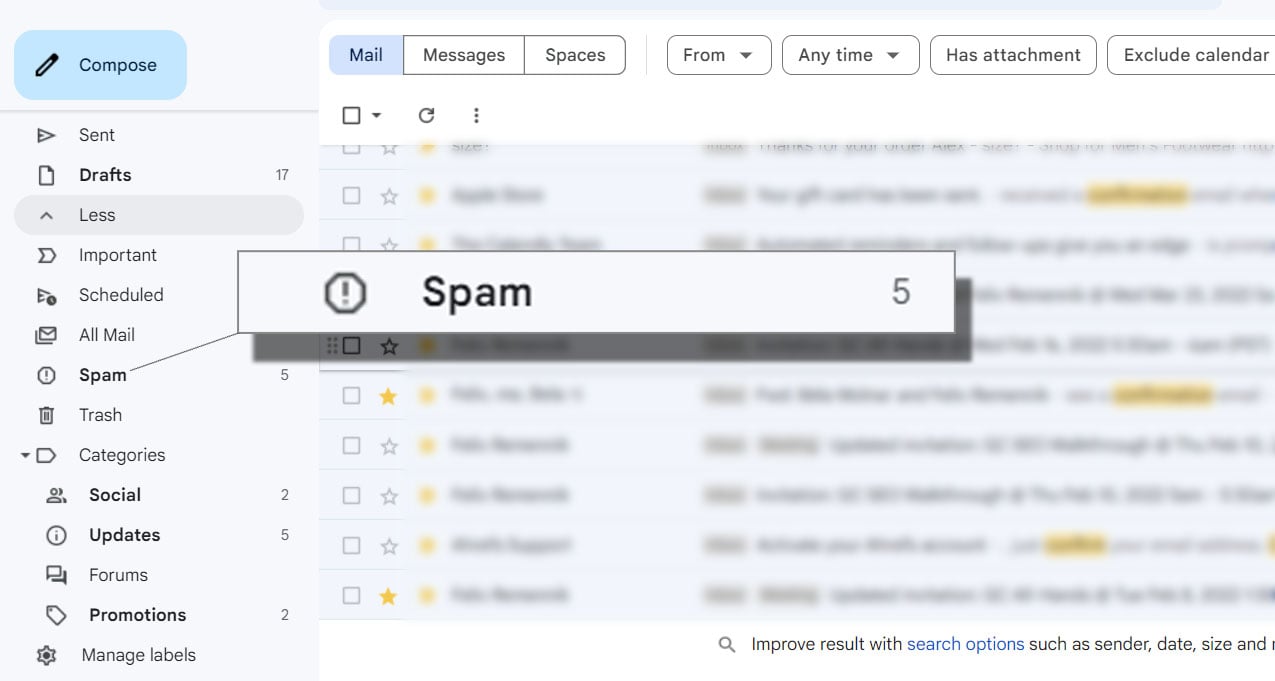
There are now stricter email marketing laws like the United States’ CAN-SPAM Act, Canada’s Anti-Spam Legislation (CASL), and the European Union’s (EU) General Data Protection Regulation (GPDR) which emphasize obtaining consent from email subscribers. Using double opt-in helps meet this requirement.
Double Opt-In Cons
1. Possible user frustration
Some email marketers balk at using double opt-in because they say it causes frustration for the user, with an extra step to take just to get into your email list. The whole point of marketing is to get prospects to engage and eventually convert in as few steps as possible.
In reality, though, the second step in double opt-in only involves clicking on a confirmation link. If a user can’t be bothered to simply open your email and click on your confirmation link, it doesn’t say much about their interest in your brand and content. Perhaps, they have other more pressing things going on in their lives, too, so they’re not ready for your content yet. You want prospects who are open and ready for your content.
2. Lose some subscribers
Some marketers are also not keen on the idea of fewer subscriber sign-ups due to double opt-in. A user who first signed up but failed to click on your emailed confirmation link is a lost contact, after all.
If a user is unwilling to double opt-in, they weren’t genuinely interested to begin with, so they will also be less likely interested in your content. If you keep emailing them, this brings down your email marketing metrics and puts you at risk for spam complaints. So, you’re better off without them in the long run.
Bottomline, it comes down to a choice of what you want for your brand. Do you want reduced spam complaints, with greater engagement and higher potential conversion from your email subscribers, and be legally compliant as well? Or, do you want a larger but less interested list populated by invalid and fake accounts, and run the risk of legal violations?
Single Opt-In Vs. Double Opt-In
A single opt-in means a user only signs up once; then they’ll start receiving your content emails. It’s different from double opt-in where a user still needs to confirm their subscription before they receive your content emails.
Single opt-in is simpler and helps you grow your email list quickly. However, it also exposes you to deliverability issues (more bounces, spam messages, and unsubscribes), and makes your brand look disreputable for not valuing and respecting a user’s privacy. It can also make you legally liable in countries where double opt-in is required.
It ultimately depends on your marketing contexts and goals. If you want faster list growth and are prepared to regularly purge your list for invalid and spam email accounts, then a single opt-in can be for you. If you’re looking at building and nurturing a cleaner and higher quality list with better potential engagement and conversion rates over the long term while avoiding legal risks, then double opt-in is for you.
Double Opt-In Countries

Double opt-in is legally required in Austria, Germany, Greece, Luxembourg, Norway, and Switzerland.
However, double opt-in emails are not a requirement under CAN-SPAM, CASL, and GDPR, although it’s a recommended best practice. Note, too, that double opt-in doesn’t guarantee GDPR compliance. Consent should be explicitly collected by using a check box with consent clauses and a link to your privacy policy in your website’s email subscription section.
There’s also a distinction between opt-in for marketing communications and opt-in for data privacy or data storage and processing. To avoid data privacy issues, comply with data privacy regulations and practice double opt-in.
Double Opt-In Email Examples
Your subscription confirmation email is the first email that your subscribers receive after they sign up. Make it easy for them to confirm by following these recommended best practices:
1. Alert them in your Subject Line.
Use action-oriented titles like “Please confirm your [Brand] subscription within [#] hours” or “Please verify your [Brand] subscription” if you don’t want to set a confirmation deadline.
Setting a confirmation deadline can be a double-edged sword. On the one hand, it emphasizes the urgency and human nature tends to pay attention to what is immediate. You’ll also impress upon your new subscribers that you mean business, and you deliver value at the outset by not wasting their or your time. So, those who do confirm within the deadline indicate their serious interest in your content.
On the other hand, those who don’t promptly check their emails after the first sign-up at your website might miss the deadline. You can solve this by placing a friendly “warning” landing page on your website that they’re directed to after they sign up, with a message such as:
Thank you for signing up! Please check your email and confirm your subscription within [#] hours.
2. Keep it short and sweet.
In the body of your confirmation email, go directly to the point and ask them to confirm. You can use copy such as this, with the tone adapted to your brand’s unique voice:
To start enjoying [Brand], you need to verify your email by clicking the button below.
[CTA confirmation button]
If the button doesn’t work, copy and paste this link into your browser:
[Confirmation link]
If you received this email by mistake, simply delete it. You won’t be subscribed. We hate spam, too.
For questions about this list, please contact [Brand’s email address]
The important thing is not only to get them to confirm promptly but to already convey the message that you are a reputable brand that respects people and values their time and space.
Study Fab’s double opt-in email example below which is not only short and sweet, but also emphasizes Fab’s core benefits in the email design, shortly and sweetly, too:
Free shipping. Free returns. Smile, it’s guaranteed!
It expresses its brand voice with simple and light energy, making the reader feel good about promptly confirming, with more value to look forward to.

Source: Mailmunch
3. Spotlight your CTA button.
Since visual communication is processed 60,000 times faster in the brain than text, emphasize your confirmation link with a visual button, image, or even a GIF to lighten the mood. Make sure the visuals are aligned with your brand voice.
Email Design’s double opt-in email example is even shorter and sweeter, with more visuals than text, and a light, pleasant feel to it. The call-to-action (CTA) button is highlighted with a more solid color against an almost white background, plus a green arrow pointing to the CTA for emphasis.
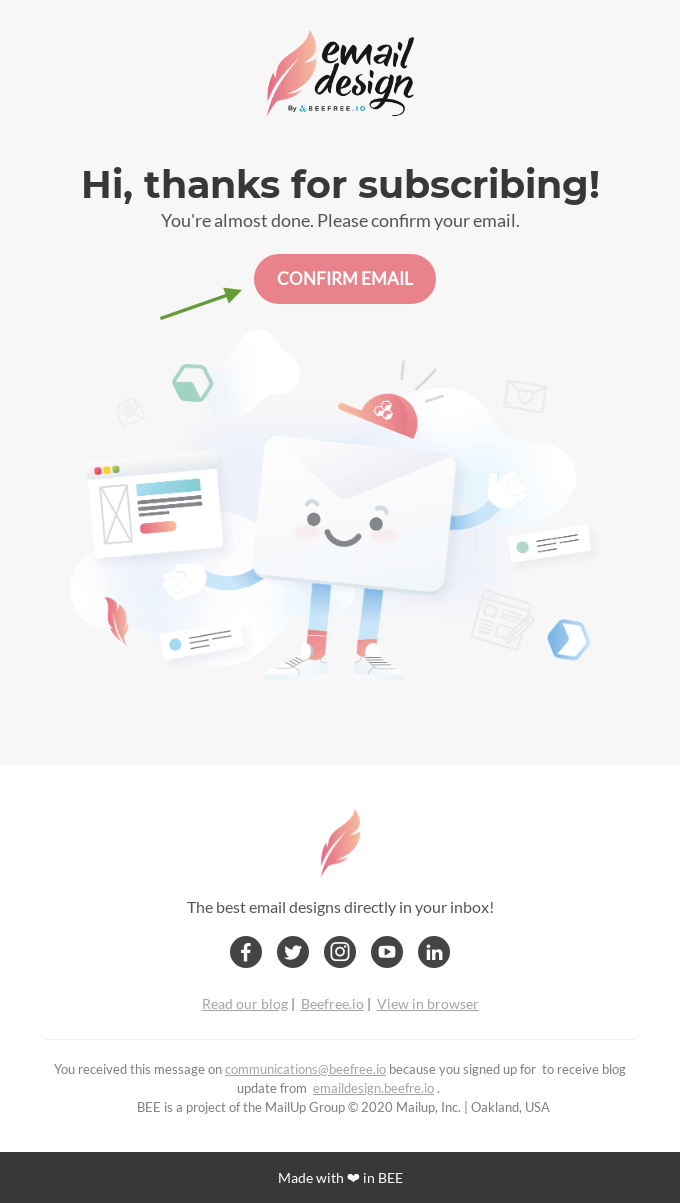
Source: Selzy
Opening and reading emails can be stressful if all emails are text-heavy. Your confirmation email will stand out, make it easy for your new subscriber to confirm, and even brighten their day. They will also remember you for it if you did it well.
4. Thank them for confirming and entice them to look forward to your future emails.
After they’ve confirmed, send them another email thanking them and welcoming them to your content, laying out for them all the juicy benefits of what they can look forward to from your emails. This can also be done in your confirmation email, then re-emphasized in the Thank You and Welcome email.
J.K. Rowling’s Pottermore double opt-in email example reflects their brand’s voice (you can imagine J.K. Rowling speaking to you here!), polite and friendly, short and sweet, with the CTA button highlighted, asking the new subscriber to verify their subscription. It also begins with a brief description of the benefits the new subscriber will be receiving after they’ve confirmed, incentivizing their prompt confirmation.
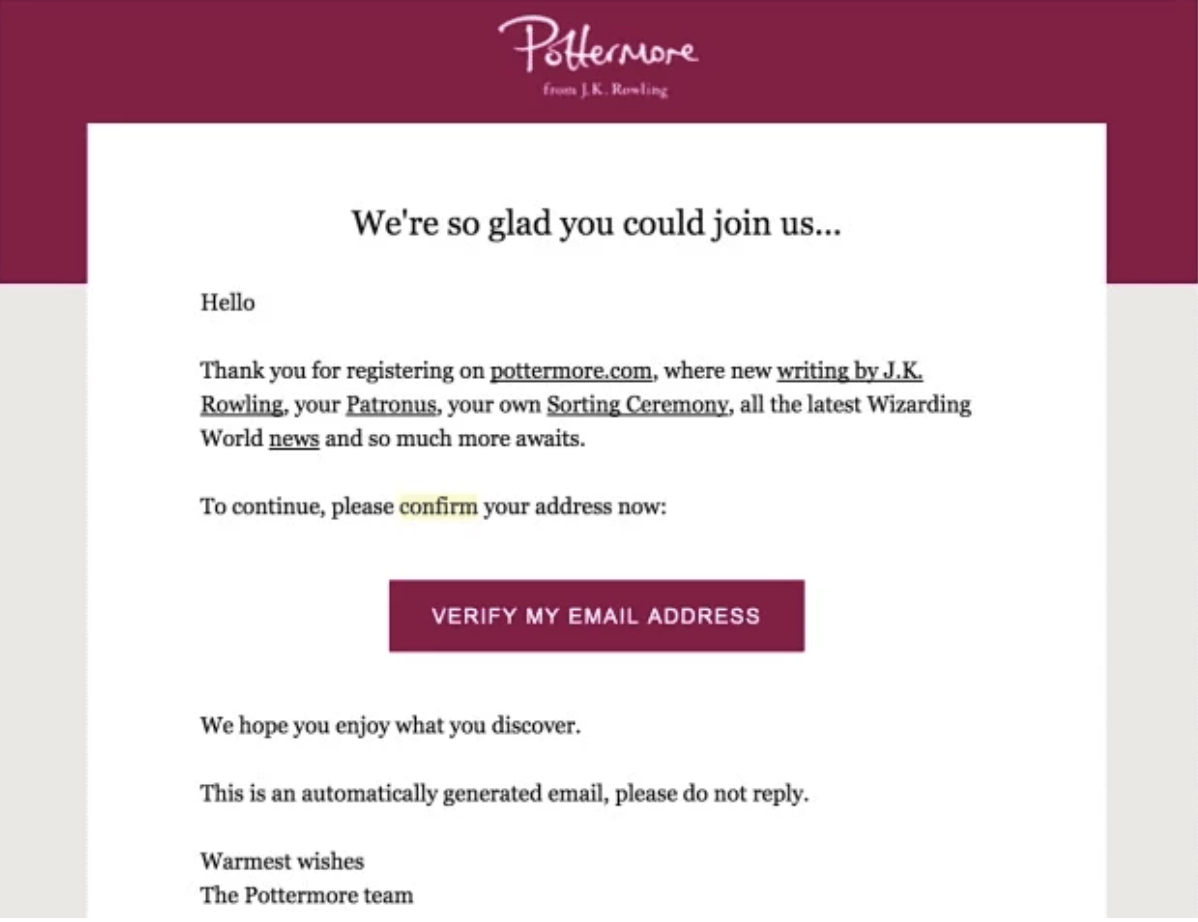
Source: Engagebay
5. Automate your emails with an auto-responder.
You should be using email marketing software such as MailChimp, Klaviyo, and HubSpot to automate your confirmation and subsequent content emails. This streamlines your campaigns and cuts down on the amount of email marketing work you do. You can also ask a professional email marketer to do all these for you.
Sign up for an account with MailChimp, Klaviyo, or Hubspot, and follow these steps to set up your double opt-in tool:
MailChimp double opt-in
- In your MailChimp account, select All Contacts (under Audience) within the navigation menu.
- From here, under Settings, select Audience name and defaults.
- Under Form settings, tick the box next to Enable double opt-in. By default, MailChimp will also enable reCAPTCHA which adds another verification step, but you can disable this if you don’t want this.
- Click Save.
Klaviyo double opt-in
Lists are already set by default to double opt-in in all Klaviyo accounts. Users are strongly cautioned against using single opt-in on any list unless it is absolutely necessary in a specific case.
Still, if you want to view and edit your opt-in settings, here are the steps:
- In your Klaviyo account, click the mailing list you want to edit.
- Select Settings.
- In the Opt-In Process page, select the box next to Single opt-in if you want to change it, or just see how the box next to Double opt-in is already pre-selected if you want to confirm so.
- Click Update List Settings.
HubSpot double opt-in
These steps are for Legacy Marketing Hub basic accounts, Marketing Hub Professional, and Marketing Hub Enterprise accounts.
- In your HubSpot account, click the Settings icon in the main navigation bar.
- On the left sidebar menu, go to Marketing > Email.
- Click the Subscriptions tab.
- Toggle the Enable double opt-in switch on.
- Click the Enable options dropdown menu to select how the double opt-in feature should be applied: All pages, Enabled for some pages only, Disable for some pages only.
- To choose a page a contact will visit after they click on the confirmation link you email them, click the Confirmation page dropdown menu, then select a landing page or website page you’ve created in HubSpot. If you don’t have a confirmation page yet, click on Create new page to make one.
- If you want to send an additional follow-up email to your contacts after they confirm their email subscription, tick the Include follow-up email checkbox. To customize and publish your email, click Publish follow-up email.
For Marketing Hub Starter and HubSpot CRM accounts:
- In your HubSpot account, click the Settings icon in the main navigation bar.
- On the left sidebar menu, go to Marketing > Email.
- Click the Double opt-in tab.
- Toggle the Send double opt-in email switch on, and customize the Sender, Double opt-in email language, and Subject line features in your settings.
9 Tips For Improving Your Double Opt-In Rate
Your email marketing depends on your opt-ins. The more opt-ins you have, the more your campaigns can grow. The ideal opt-in rates should be between 5% to 25%, depending on your industry. If you have less than 5%, you’re probably not clear about who you’re selling to as one of several causes. Consider using double opt-in to get the quality subscribers you want and need.
Here are nine (9) best practices for improving your double opt-in rate.
- Make sure your site loads fast.
- Capture your visitors’ attention within 0.05 seconds with the way your site is designed.
- Look good on both desktop and mobile.
- Use stunning visuals.
- Write great copy.
- Do A/B testing on all landing pages.
- Keep the forms short.
- Remove all distractions (such as too many outbound links and social sharing buttons)
- Be safe and trustworthy (use HTTPS, SSL protection, full contact details, social proof with awards and certification, etc.).
These best practices imply that you’d need a good website designer and email marketing team. You can scout for them yourself, or you can hire pre-vetted, professional specialists within 24 hours from Toptal.
FAQs
1. Does double opt-in improve deliverability?
Yes. It eliminates invalid email addresses, prevents spam complaints, and protects your brand reputation.
2. What does double opt-in prevent?
Double opt-in prevents invalid and spam email addresses from getting into your mailing list, and minimizes your legal risks for violations of data privacy.
3. Is double opt-in required by GDPR?
No, but it is a recommended best practice. Explicitly obtain consent by asking users to tick a check box with consent clauses and a link to your site’s data privacy policy in the email subscription section.
Why You Need Double Opt-In
Double opt-in is confirmed opt-in. Subscribers to your mailing list not only sign up for it but verify their sign-up. This shows their genuine interest in your content. This also helps you prevent invalid and spam email addresses from getting into your list, increases deliverability and potential for real engagement with your target customers, promotes legal compliance, and protects your brand reputation.
Even if single opt-in grows your mailing list faster, double opt-in makes it cleaner and more lasting.



